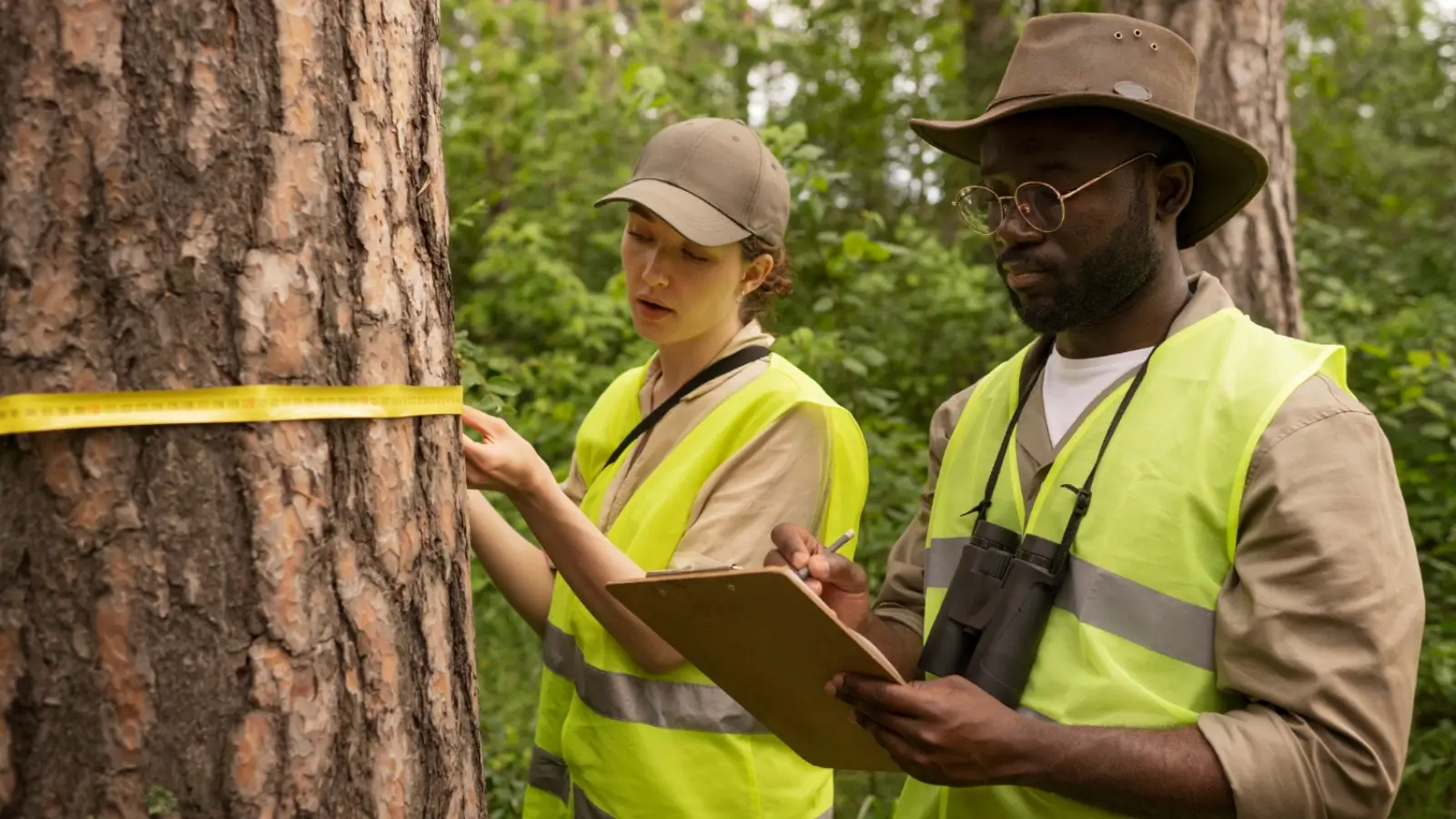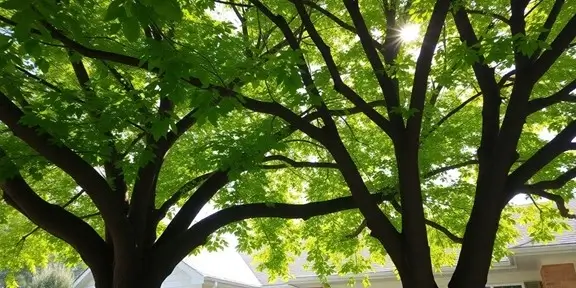


Trees can get sick or infested just like any other living thing. Sometimes, these problems aren't obvious at first glance. Things like fungal infections or tiny insects can start causing damage inside the tree, weakening it over time.
Catching these hidden tree ailments early is key. Grant Brothers, a professional tree care service highlighted by Virginia Tree Care, offers expert arborist inspections to detect these issues before they escalate.
An arborist knows what to look for, like subtle changes in leaf color or bark texture, that might signal a problem before it becomes serious.
Once a disease or pest is identified, acting fast makes a big difference. Getting prompt treatment for tree health can stop the issue from spreading. This might involve special sprays, treatments applied to the soil, or even careful pruning to remove affected parts. The goal is to help the tree fight off the problem and recover, keeping it healthy and strong.
One sick tree can quickly become a problem for many trees on your property. If pests or diseases aren't managed, they can spread easily to nearby trees, leading to widespread infestations. Regular inspections help prevent this by catching issues when they are isolated. This proactive approach saves not only the affected tree but also protects the rest of your landscape from costly damage and potential loss.
Trees are beautiful additions to any property, but they can also pose significant risks if not properly maintained. Ignoring potential issues can lead to serious property damage and even liability problems. Regular inspections help identify and address these risks before they escalate.
A tree's structural integrity is paramount to preventing damage. Over time, trees can develop issues like hollow trunks, weakened root systems, or cracks that aren't always visible to the untrained eye. These hidden problems can make a tree unstable, increasing the risk of it falling or dropping large limbs, especially during severe weather. An arborist can assess these structural weaknesses, looking for signs of decay, disease, or damage that compromise the tree's stability. This assessment is key to understanding which trees might be a liability.
Weakened trees are a major source of property damage and personal injury. A falling limb can damage roofs, vehicles, or outdoor living spaces. Worse, a whole tree falling can cause extensive destruction and lead to costly repairs. By identifying trees with compromised structures through regular inspections, you can take preventative measures. This might involve pruning hazardous limbs, cabling or bracing unstable trees, or, in some cases, removing the tree altogether. This proactive approach helps prevent unexpected accidents and protects your home and family from potential harm. It's about mitigating risks before they become costly problems.
Homeowners' insurance policies often have clauses regarding the maintenance of trees on your property. If damage occurs due to a tree that was clearly neglected or known to be unhealthy, your insurance claim might be denied. Regular tree inspections and necessary maintenance, like pruning or removal of hazardous trees, provide a documented record of your due diligence. This can protect you from liability if a tree causes damage or injury to a neighbor or their property. It’s a smart way to avoid potential lawsuits, increased insurance premiums, and the significant financial burden of property damage. Ultimately, it offers peace of mind, knowing you've taken steps to secure your environment.
Trees, like any living thing, need the right conditions to thrive. Regular inspections help spot early signs of trouble, such as slow growth or yellowing leaves, which can point to nutrient deficiencies or soil issues. Addressing these problems with targeted fertilization or soil amendments can make a big difference in a tree's long-term health. It’s about giving them what they need to live a long, full life.
Think of tree care as an investment in your property's future. By catching diseases or pest infestations early, arborists can treat them before they cause serious damage. This proactive approach significantly extends a tree's lifespan, sometimes by decades. Healthy, long-lived trees add beauty and character to your landscape year after year.
Well-maintained trees do more than just look good; they actually increase your property's value. Buyers notice attractive landscaping, and mature, healthy trees are a big selling point. Keeping your trees in top shape through regular inspections and care can boost your home's curb appeal and add to its overall equity. It’s a smart way to make your property more desirable.

Many homeowners view regular tree inspections as an added expense, but this perspective often overlooks the significant savings achieved through preventative care. When you compare the cost of routine maintenance to the potential expenses of emergency tree removal or extensive property repairs, the financial benefits of proactive tree management become clear. Investing in regular check-ups is a smart financial decision that protects your property and your wallet.
Waiting for a tree to show obvious signs of distress or damage often means dealing with an emergency situation. These scenarios are almost always more costly. An emergency tree removal, especially one required after a storm or when a tree has already caused damage, can run into thousands of dollars. This includes not only the removal itself but also potential costs for debris cleanup, property repair, and even liability if someone is injured. A proactive approach, identifying and addressing issues like weak branches or early signs of disease before they become critical, can prevent these high-cost emergencies.
Regular inspections help catch problems early, such as pest infestations, nutrient deficiencies, or structural weaknesses. Addressing these issues promptly through targeted treatments or pruning is far less expensive than dealing with the consequences of neglect. For instance, treating a pest infestation early can save a tree that might otherwise die and require costly removal and replacement. Similarly, pruning hazardous limbs can prevent them from falling and damaging your home, vehicles, or landscaping, thus saving on future repair bills.
Ultimately, the financial benefits of regular tree inspections are substantial. By investing a small amount in consistent care, property owners can avoid much larger expenditures down the line. This preventative strategy is key to maintaining healthy, safe trees that add to your property's value rather than becoming a costly liability. Think of it as an investment in your property's long-term health and financial security. The cost-effectiveness of these inspections is undeniable when considering the potential damage they help avert.
Every yard is different, and so are the trees that call it home. A professional arborist can look at your specific trees and the soil they're growing in. They'll figure out what each tree needs to stay healthy and strong. This means looking at things like sunlight, water, and even the surrounding plants.
Based on what they find, arborists can give you advice that's just for your trees. This might include when and how to prune them, what kind of fertilizer to use, or if the soil needs any special treatment. Getting this tailored tree care means your trees get exactly what they need to thrive.
For a more organized approach, especially if you have several trees, a custom plan is a great idea. This plan outlines regular check-ups, specific treatments, and preventative measures. A good tree management plan helps prevent problems before they start, saving you money and hassle down the road. It's all about keeping your trees healthy and your property safe.

Trees face different challenges depending on the time of year. Understanding these seasonal threats helps property owners prepare and protect their trees. Regular inspections are key to staying ahead of potential problems.
Spring and summer bring active growth, but also risks like fungal diseases and insect infestations. Heavy rains and storms can also occur, stressing trees. An arborist can spot early signs of disease or pest activity, like unusual leaf discoloration or small holes in the bark. They can also assess a tree's structure for weaknesses that might fail under strong winds or heavy rain. This proactive approach helps prevent damage before it happens, keeping your trees healthy during the active growing season.
As temperatures drop, trees prepare for dormancy. Fall is a time when decay can become more apparent, and some pests might overwinter in tree bark. Inspections can identify dead or dying branches that could break under snow or ice. Addressing these issues before winter sets in is important. Winter itself brings its own set of stresses, from freezing and thawing cycles affecting roots to heavy snow loads on branches. Seasonal awareness means preparing trees for these conditions.
Consistent, seasonal tree care is about building resilience. By addressing issues as they arise throughout the year, you help trees develop stronger defenses. This includes proper pruning to remove weak limbs, soil amendments to improve nutrient uptake, and pest management. A well-maintained tree is better equipped to handle the stresses of changing weather patterns and environmental factors. Investing in regular inspections means you're not just reacting to problems; you're actively working to keep your trees strong and safe year-round. This consistent care is vital for tree resilience.
When severe weather hits, the last thing anyone wants is to worry about falling branches or entire trees toppling over. A professional tree inspection provides that much-needed reassurance. Certified arborists can identify potential weaknesses, like decay or structural flaws, that might not be obvious to the average homeowner. This expert evaluation means you can feel more confident about your property's safety, especially when strong winds or heavy rain are in the forecast. Knowing your trees have been assessed by someone who understands their health can significantly reduce anxiety during storm events.
Trees are living things, and their condition can change over time. Without regular check-ups, it's easy to be uncertain about whether a particular tree poses a risk. Is that leaning trunk just a quirk, or a sign of root problems? Are those dead branches merely unsightly, or a falling hazard? An expert evaluation removes this guesswork. Arborists are trained to spot subtle signs of disease, pest infestation, or structural compromise that could lead to future problems. This clarity helps property owners make informed decisions about tree care, rather than just hoping for the best.
When you have visitors over, whether it's for a backyard barbecue or a holiday gathering, you want them to feel safe and welcome. Overhanging branches or unstable trees can create a liability if something were to happen. Regular tree inspections help address these concerns proactively. By having your trees evaluated by a professional, you can ensure that your property is not only beautiful but also a secure environment for everyone. This peace of mind extends to knowing you've taken reasonable steps to maintain a safe property, which is important for both personal comfort and legal protection.
So, really, getting your trees checked out regularly just makes sense. It’s not just about keeping them looking nice; it’s about avoiding a whole lot of trouble down the road. Think about it – catching a disease early or spotting a weak branch before it falls can save you a ton of money on repairs, not to mention the headache. Plus, healthy trees actually make your place look better and can even add to its value. It’s kind of like going to the doctor for a check-up; you do it to stay healthy and catch problems early. For your trees, it’s the same idea. It’s a small step that can prevent big, expensive issues later on.